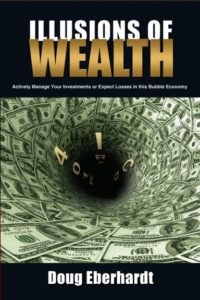“Fool me once, shame on — shame on you. Fool me — you can’t get fooled again.” George W. Bush
While people have laughed at former President George Bush’s attempt in getting a quote right in the above video, it looks like Bush is also wrong in saying “you can’t be fooled again.”
Are we Americans getting fooled again? If so, by whom?
To answer these questions, take a look at what’s been going on at the Federal Reserve that past few years and see how their quest for more power and control is just an attempt at fooling the American public into thinking they have everything under control. In reality, the Federal Reserve has brought us to the brink of collapse. You just can’t see it yet.
RECENT HISTORICAL PERSPECTIVE OF FEDERAL RESERVE QUEST FOR MORE POWER
3/29/2008 -Bush Proposes More Power for Fed
On March 29th 2008, the Bush administration proposed a sweeping overhaul of the way the nations financial industry would be regulated, including recommending more powers for the Federal Reserve.
The Fed would become the government’s “market stability regulator,” given sweeping powers to gather information on a wide range of institutions so that Fed Chairman Ben Bernanke and his colleagues could better detect where threats to the system might be hiding.
7/30/2008 – Congress Votes To Keep People in their Homes
Shortly after this Bush proposal, Congress, in a bipartisan effort, passed Nancy Pelosi’s bill, H.R. 3221, the Housing and Economic Recovery Act of 2008. The vote was 72-13, with 15 Senators not voting, including McCain and Obama.
This is the bill that was passed to keep people in their homes and try and get more individuals suckers to purchase homes with only a 3.5% down payment through an FHA program. People who bought homes at the wrong time are thus rewarded and people who don’t have the wherewithal of knowing when is the best time to buy real estate were given free gifts from the U.S. taxpayer. The rest of you paid for it.
Embedded in the Housing and Economic Recovery Act was the first granting of power to the Federal Reserve under Sec. 1118.
CONSULTATION BETWEEN THE DIRECTOR OF THE FEDERAL HOUSING FINANCE AGENCY AND THE BOARD OF GOVERNORS OF THE FEDERAL RESERVE SYSTEM TO ENSURE FINANCIAL MARKET STABILITY
9/23/08 – Stock and Real Estate Market Continue To Fall
As the stock and real estate markets continued to fall, on September 23rd, 2008, Treasury Secretary Paulson and Bush appointee Federal Reserve Chairman Ben Bernanke went on the record urging Senators to pass some sort of rescue plan with the intent of giving the Federal Reserve even more power to manipulate the markets. In reality, it was the Federal Reserves manipulations to begin with that was causing the market turmoil as Thomas Woods pointed out in his book, “Meltdown.”
Thomas Woods takes the Austrian economic approach as to why the markets failed. In a nutshell, the Fed kept interest rates too low for too long rather than let the free market dictate. This encouraged/fooled businesses into taking on more credit, expanding the boom period, which was followed by the inevitable bust we are experiencing now when the carpet was pulled from underneath them.
Only the pompous folks at the Federal Reserve would have the gall to ask for more power while causing the bust to begin with. The fact that many in America don’t see the connection; “Fool me once.”
The housing and stock market continued to fall in 2008 despite the attempt by Congress and the Fed collusion in helping homeowners. Certain derivative bets were falling apart causing the collapse of Bear Stearns, Lehman and AIG and threatening many other financial institutions while investors were running to Treasuries for safety.
Paulson, Bernanke Urge Senators to Pass Rescue Plan
10/08/2008 - “Emergency, Emergency” Gomer Pyle the Paulson, Bernanke, Geithner Show
Congress passes the H.R. 1424 – Emergency Economic Stabilization Act of 2008 aka TARP. Almost all Democrats and 47 Republicans voted for this bill.
On a side note, does it make sense to vote for those who are in favor of such bills that would threaten the system? Why not vote them out? But you may not be convinced yet as to the reasons why they need to be voted out. Digging deeper might shed some light.
This Emergency act gave the Federal Reserve even more power to stabilize the financial markets through the purchase of troubled assets:
TROUBLED ASSETS- The term ‘troubled assets’ means–
(A) residential or commercial mortgages and any securities, obligations, or other instruments that are based on or related to such mortgages, that in each case was originated or issued on or before March 14, 2008, the purchase of which the Secretary determines promotes financial market stability; and
(B) any other financial instrument that the Secretary, after consultation with the Chairman of the Board of Governors of the Federal Reserve System, determines the purchase of which is necessary to promote financial market stability, but only upon transmittal of such determination, in writing, to the appropriate committees of Congress.
If you own a flower shop or local restaurant and business has slowed down to a halt because of the economy, you are not deemed necessary to financial market stability and failure is your only option. If you have given millions to politicians on both the left and the right showing loyalty to the Parties in charge, you’re allowed to survive.
Who Allows Your Business to Survive?
The Financial Stability Oversight Board was established under this bill to decide which assets were deemed troubled. This Board is comprised of– (1) the Chairman of the Board of Governors of the Federal Reserve System; (2) the Secretary; (3) the Director of the Federal Housing Finance Agency; (4) the Chairman of the Securities Exchange Commission; and (5) the Secretary of Housing and Urban Development.
Congress Is Assured Transparency and Disclosure by the Fed
This bill was also supposed to make the Federal Reserve provide some sort of transparency so the public could see what shenanigans the folks at the Federal Reserve were up to.
SEC. 114. MARKET TRANSPARENCY.
(a) Pricing- To facilitate market transparency, the Secretary shall make available to the public, in electronic form, a description, amounts, and pricing of assets acquired under this Act, within 2 business days of purchase, trade, or other disposition.
(b) Disclosure- For each type of financial institutions that sells troubled assets to the Secretary under this Act, the Secretary shall determine whether the public disclosure required for such financial institutions with respect to off-balance sheet transactions, derivatives instruments, contingent liabilities, and similar sources of potential exposure is adequate to provide to the public sufficient information as to the true financial position of the institutions. If such disclosure is not adequate for that purpose, the Secretary shall make recommendations for additional disclosure requirements to the relevant regulators.
11/11/2008 – Federal Reserve Gone Wild
Instead of transparency and disclosure, we ended up with the Fed refusing to disclose anything to anyone. If any other entity did this, the media would be all over it exposing such a con. Where is the media exposure? The media for the most part has been silent, but there are some people reporting what’s going on daily. While others are doing their part to expose the truth. and the Campaign for Liberty keeps folks on track offering their own transparency of Congress and the Fed.
For the most part, who really believes Bernanke and the Federal Reserve would abide by any rules set forth to begin with? Did the congressmen and women who voted for it believe the words of Paulson and Bernanke? Did they even read the bills they passed into law? The self interest of these folks is evident by their actions. But for whose benefit, yours?
“Just the Facts”
“Fed Defies Transparency Aim in Refusal to Disclose [$2 Trillion in taxpayer loans to banks]
“The Federal Reserve is refusing to identify the recipients of almost $2 trillion of emergency loans from American taxpayers or the troubled assets the central bank is accepting as collateral.” … “Fed Chairman Ben S. Bernanke and Treasury Secretary Henry Paulson said in September they would comply with congressional demands for transparency in a $700 billion bailout of the banking system. Two months later, as the Fed lends far more than that in separate rescue programs that didn’t require approval by Congress, Americans have no idea where their money is going or what securities the banks are pledging in return.” … ““The collateral is not being adequately disclosed, and that’s a big problem,” said Dan Fuss, vice chairman of Boston- based Loomis Sayles & Co., where he co-manages $17 billion in bonds. “In a liquid market, this wouldn’t matter, but we’re not. The market is very nervous and very thin.”” … “Bloomberg News has requested details of the Fed lending under the U.S. Freedom of Information Act and filed a federal lawsuit Nov. 7 seeking to force disclosure.” … “The Fed made the loans under terms of 11 programs, eight of them created in the past 15 months, in the midst of the biggest financial crisis since the Great Depression.” … ““It’s your money; it’s not the Fed’s money,” said billionaire Ted Forstmann, senior partner of Forstmann Little & Co. in New York. “Of course there should be transparency.”” -By Mark Pittman, Bob Ivry and Alison Fitzgerald; Bloomberg
But it’s not just 2 Trillion the Fed is playing with. They have managed to put the U.S. Taxpayers at risk for $9.7 Trillion in future pledges, or as Bloomberg put it, “enough to pay off more than 90 percent of the nation’s home mortgages.”
The $9.7 trillion in pledges would be enough to send a $1,430 check to every man, woman and child alive in the world. It’s 13 times what the U.S. has spent so far on wars in Iraq and Afghanistan, according to Congressional Budget Office data, and is almost enough to pay off every home mortgage loan in the U.S., calculated at $10.5 trillion by the Federal Reserve.
Bloomberg along with the NyTimes ended up suing the Fed to get full disclosure.
A federal judge in Manhattan ruled in Bloomberg’s favor last November, and a three-member panel of appellate judges upheld that ruling in March. But last week the Fed asked the full United States Court of Appeals for the Second Circuit to take up the case.
The Fed will go to all ends to keep the truth from U.S. taxpayers. These same Congressmen and women who gave the Fed more powers through the bills described above are still at it today pulling the wool over your eyes by offering a watered down Audit the Fed bill instead of the original version offered by Alan Grayson and Ron Paul.
The Truth Be Known – It’s All a Con Game
When an investor makes a decision on buying company A over Company B, they do their due diligence, look at each companies financial balance sheets and make an informed decision as to whether to put their hard earned money into the company in anticipation of seeing it grow in value.
Those who are more adverse to risk, like many seniors these days, will put their money in Treasuries and assume the small amount of interest they receive will go towards paying their bills and keeping pace with inflation.
What would an investor or senior do if they didn’t have access to a companies balance sheet or didn’t know anything about the assets on the balance sheet? Would they invest?
Well guess what folks…if you have money in a bank, money market or in Treasuries, you don’t know what’s in the Fed’s balances sheet and you are that investor. But after some digging, I did find what’s in the Fed’s wallet.
The Federal Reserve’s Balance Sheet
Since 1971, the Federal reserve has kept a balance sheet consisting of about 70% in U.S. Treasury Securities as seen in the chart below.
That started to change towards the end of 2007. By the end of 2008, the Federal Reserve had approximately 22% in Treasuries, a 48% decrease in the levels experienced the last 40 years . Are seniors aware of this? Is anyone?
Author Peter Stella: Monetary and Capital Markets Department
Just What Are the Assets the Fed Carries on Their Books if Not Treasuries? Are They Safe?
Take a look at the following chart and you’ll see that instead of Treasury Securities, 78% of the Federal Reserves balance sheet consists of approximately $2.2 Trillion of all those assets they’ve been accumulating under the TARP program thanks to Congress giving them the authority to do so.
For better viewing click here (will open in new window)
Perhaps some of you reading this today feel safe with your investments believing Bernanke and the Federal Reserve have indeed pulled us out of this recession. But if you really sit down and analyze the green shoots pushing the stock market higher, they are fueled only by the false hopes provided by government spending.
Whether it be cash for clunkers, appliances, homes or buyouts of failed institutions, they are the same false hopes the Federal Reserve provides time and time again, the hopes that turn to fear and despair as the inevitable bust arrives.
Don’t expect anything different this time around except a harder fall. Just look at the Fed’s balance sheet for proof. Then add to that Fannie and Freddie’s future obligations.
Sorry GW…you can get fooled again and thanks a bunch for making sure of it. But you don’t have to be fooled twice…
If you want to see an end to this Congressional and Federal Reserve madness then you must contact your senators now and have them vote YES for Congressman David Vitter’s amendment which contains the Audit the Fed language that passed the House last fall.
Don’t be fooled by the media’s attempt to sugar coat any audit with a quasi attempt like what is being pushed through Congress now and supported by the White House.
Know the difference. Contact your senator now!







[…] at pulling the wool over the People’s eyes I had discussed yesterday has succeeded. See The Federal Reserve Con Game Don’t be fooled by the media’s attempt to sugar coat any audit with a quasi attempt like what […]